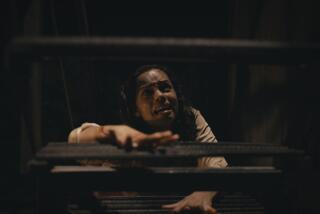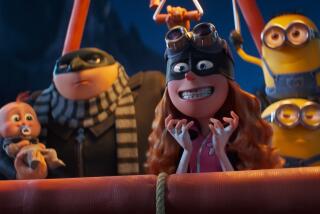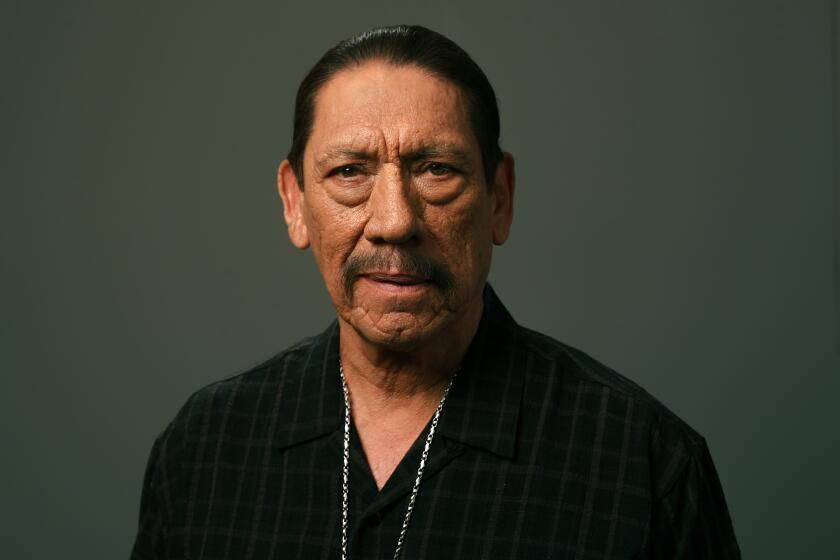A devil of a time
It was wintertime in Rome when the curse of “The Exorcist” befell Renny Harlin. In December 2003, the director was two weeks into filming “The Exorcist: the Beginning,” a prequel to William Friedkin’s landmark 1973 horror classic, when he was hit by a car as he stepped onto an Italian street. Harlin’s leg was shattered and required the surgical insertion of 14 pins. Worse still, production on the film -- which even in the disaster-ridden annals of Hollywood ranks as one of the most troubled ever -- ground to a halt for two weeks while he convalesced. Returning to the set, he directed the remaining six shooting weeks on crutches -- and with a newfound respect of the shadowy beyond.
“Not to sound ridiculous, but I think it must have been a warning from somewhere,” Harlin said. “If you want to talk about a curse, ominous things happened throughout filming and post-production. There are dark powers in the world. And these are things you can’t take lightly.”
Despite his physical injuries, he may have gotten off easy.
Fourteen years after its inception, three directors, six screenwriters, two supporting casts and two leading men later, Harlin’s “Exorcist” will receive widespread theatrical distribution this Friday. For the horror movie to reach theaters at all, reputations have been tarnished, egos bruised, a sizable personal fortune has been spent -- twice -- and enough mud has been slung that the movie’s bad press threatens to overwhelm any discussion of the possible merits of “The Exorcist: the Beginning.” (Warner Bros., the film’s distributor, chose not to screen the movie for review.)
Its original director, John Frankenheimer, was hospitalized for spinal surgery during preproduction in 2002 and died of a stroke a few weeks later. After principal photography in Africa and Italy wrapped in February 2003, his replacement, Paul Schrader, had the film taken away from him by Morgan Creek, the production company that financed the movie. Then in October, the highly unusual decision was made to essentially scrap Schrader’s film and bring in Harlin to film an almost entirely different version with a nearly completely new cast.
Morgan Creek’s president, James Robinson, said that Schrader’s version of the film cost more than $40 million and that Harlin’s cost even more, not including prints and advertising. That means more than $100 million has been spent to bring “The Exorcist: the Beginning” to the screen. At some point, Schrader’s version will also receive a limited release. “But not, obviously, at the same time we release Renny’s,” said Robinson, who had previously said Schrader’s version likely would debut only on cable TV or video.
One constant in both films is Stellan Skarsgard, who played the lead, Father Lankester Merrin, for the two directors. “That guarantees me a place in a trivia game, doesn’t it?” Skarsgard said.
In the beginning, before there were two versions of “The Exorcist: the Beginning,” there was a single script. In 1990, after “The Exorcist III: The Legion” turned a modest profit, Robinson commissioned “Terminator 2: Judgment Day” writer William Wisher to create an “Exorcist” prequel. The resulting screenplay flashed back 30 years to tell the story of Father Merrin (the Max Von Sydow character who clashes with Satan in the original) as a young priest who confronts the devil -- and his faith -- in post-World War II Kenya.
But it languished in the studio’s vault for 10 years until bestselling historical novelist Caleb Carr, who had been hired by Morgan Creek to work as a script doctor, stumbled upon the screenplay and drummed up new excitement for the project.
“For a year-and-a-half, I would go to them and say, ‘Please let me work with this. I think you really have something here if you take a different approach with it,’ ” Carr said. “I pleaded with [studio executives] to let me rewrite it and sketched out this whole new concept for them.”
Carr’s treatment was to serve as a high-minded antidote to previous “Exorcist” sequels: John Boorman’s 1977 “Exorcist II: The Heretic,” which came to be ranked second by the Golden Turkey Worst Movie of All Time awards, and original “Exorcist” writer William Peter Blatty’s disjointed “Exorcist III,” which was savaged by critics. Carr’s movie begins “Sophie’s Choice”-style in Holland in 1944, when a young Father Merrin is forced by an SS officer to select some of his parishioners for execution. From there the plot jumps to East Africa three years later, where Merrin, no longer a priest and burdened with intense spiritual anguish, is an archaeologist. There, he uncovers an ancient religious site -- a place of percolating evil.
On the strength of the script, Frankenheimer, the award-winning director of 1962’s “The Manchurian Candidate,” signed on and Liam Neeson won the role of Father Merrin.
“It was smooth sailing,” Carr said. “It was a happy group of people. Everybody liked each other and got along.” Shooting was scheduled to begin in the summer of 2002. But the 72-year-old director was in frail health, and following spinal surgery, he dropped out of the project. Neeson quickly followed suit. Nonetheless, Morgan Creek executives remained committed and hired Schrader, the provocative auteur who wrote the screenplays for “Taxi Driver” and “Raging Bull” and who had had a run of box office luck directing modestly budgeted indies such as “Auto Focus” and “Affliction.” Although he hadn’t been entrusted to make a studio movie since his 1982 flop, “Cat People,” the studio took a chance.
It was an awkward marriage of sensibilities -- Morgan Creek, whose biggest hit had been “Ace Ventura: Pet Detective,” handing the reins of a high-brow horror movie written by a serious author to the former party animal who wrote “The Last Temptation of Christ.”
“What was ultimately appealing to me about it -- that it wasn’t really a hard-core horror movie -- proved to be my undoing,” Schrader said. “I felt you couldn’t get very far with the horror angle since the original was so well known and had been copied so many times. And the mantra at the time was: no pea soup, no spinning heads.”
Acclaimed cinematographer Vittorio Storaro (who also ended up shooting Harlin’s version) signed on, and Schrader hired Skarsgard, who is one of Lars von Triers’ franchise players, to play Father Merrin. Carr, however, was made aware that his services would no longer be necessary.
“Paul and I had a three-hour phone conversation,” Carr said. “And it became very clear that A) Paul doesn’t think much of the script and thought he could improve it with his shooting of it, and B) he didn’t want me around when that happened.”
Schrader said he made a few cosmetic changes to Carr’s script but that he tried to stay faithful to the source material.
“The Frankenheimer/Carr script was a bit too talky, too dialectic,” Schrader said. “Long conversations between Merrin and the devil. I made an attempt in a small way to make it more taut, less intellectual and a little more frightening. But it was the same script I was given.”
In late 2002, Schrader and company moved the production to Morocco (standing in for Kenya in the movie) for five weeks of shooting. Then came the first hints that Morgan Creek’s Robinson was dissatisfied.
“Things were going well,” Schrader said. “Then Jim came and saw dailies and said, ‘It isn’t scary enough.’ ” He tried to amp up the movie’s scare factor while still adhering to the original script. But after shooting for five more weeks at Rome’s Cinecitta Studios, communication between director and producer broke down -- Robinson stopped speaking to Schrader.
Schrader hastily edited the film, a moody period piece Skarsgard calls “a $40-million art film” and then saw his editor fired by Morgan Creek. He oversaw a subsequent edit but had final cut taken away from him.
“I said, ‘The problems you have with this film are not editing problems,’ ” Schrader said. “ ‘They are story problems. You can’t reedit this film because the material was never shot. You have to go back to the writing stage if you want to change this.’ So then they realized no amount of editing is going to make this cow a camel, and they wanted to bring in a new director.”
After more than a month of legal wrangling, Schrader was given his walking papers. Despite appearances, Robinson insists the director was never outright dismissed.
“I never fired Schrader,” he said. “How could I have ‘exorcised him’ like the press reports say, if I let the guy direct the whole movie and gave him three cuts?” (Schrader says he was given two.)
In October 2003, Robinson met with Harlin, the Finnish director of commercial thrillers such as “Deep Blue Sea” and “Die Hard 2: Die Harder,” but also the bomb “Cutthroat Island,” to discuss constructing another film using bits and pieces of the earlier movie.
“They were wondering: What can we do? Can we insert a few scenes and spice it up to make it more suspenseful?” Harlin remembered. “I said, ‘The only way to have a scary film is to start from scratch.’ ” Soon he was given the go-ahead by Morgan Creek.
Harlin began working with screenwriter Skip Woods to retool Carr’s prequel in an effort to answer some of the questions he felt lingered from the original “Exorcist.” Woods had committed to another project, and Alexi Hawley was brought on to complete the script that would eventually be shot.
“There was a little bit of hesitation about what to do,” Hawley said. “There was a lot of criticism out there that Morgan Creek just wanted more gore, which is not fair. There was a sense that it needed to be a scary movie -- if I, as an audience member, pay to see this movie, I want to be scared.” Father Merrin’s backstory -- defrocked priest brought in to do archaeological work on an ancient crypt in Kenya -- was kept. But the rest of the film was restructured, characters were rewritten and then recast. English actor James D’Arcy replaced Gabriel Mann, who plays a piously heroic priest in Schrader’s version. And a doctor character, played by French actress Clara Bellar in the original, was rewritten for former Bond girl Isabella Scorupco.
Skarsgard was a bit skeptical about having to revisit his character. But he agreed to return once Harlin was on board. From there, the production returned to Morocco and Cinecitta, where extensive sets had to be rebuilt. But this time around, conforming to Harlin’s shooting style, special effects, green-screen and computer-generated imagery were incorporated into the film.
“Everybody said, ‘Ciao bello!’ when I returned to Rome,” Skarsgard said. “The crew and the clothes were the same. That was a strange feeling.” Although Robinson characterizes Harlin’s film as a reworking of Carr’s original script, Hawley and Harlin say their film is 95% different from Schrader’s.
“In terms of material, in a two-hour movie, there are maybe 20 seconds of landscape shots that we didn’t shoot,” he said. “We used a couple of landscape shots of Africa.”
Schrader attributes Morgan Creek’s remake of his movie to an expensive case of buyer’s remorse.
“They went out and bought one thing, then realized they had made a mistake,” he said. “They bought a Lexus and said ... I shoulda bought a Hummer!’ Then they went out and bought a Hummer. Now there’s a Lexus and a Hummer parked side by side in the Morgan Creek garage.”
Robinson, whose personal fortune bankrolls Morgan Creek, disputes the characterization. “I never said I didn’t like that Paul Schrader film! He directed the script we all agreed to, but when it came in, it was too cerebral. Too tame. But I have a lot of money invested in. Why would I not try to put it out there?”
“One piece of idiocy is not made better by two pieces of idiocy,” Carr observed.
Ultimately, Robinson knows exactly what it will take to make his big gamble worthwhile. “I get out with my money if we open at $40 million,” Robinson said, hoping for a debut weekend that not even the modest hit “Alien vs. Predator” managed to reach. “If we hit that, nobody wins, nobody loses.” In the final analysis, Robinson said, he feels he made the right decision.
“Granted, you probably never heard anybody going back to reshoot a movie,” he said. “But I did it. I did it because I thought ‘The Exorcist’ needed to continue on as a highly commercial, scary franchise.
“Paul gave it his best shot. I gave it my best shot. Renny gave it his best shot. I’m not looking back saying, ‘I wish I had done things this way and that.’ That’s how it is in life: we try, and hopefully the public will embrace one of these movies.”
On Saturday, Schrader says he knows what he will be doing. “Me and Blatty are going to see the movie,” he said, breaking into a chuckle. “Stellan says he wants us to take a picture in front of the theater!”
More to Read
Only good movies
Get the Indie Focus newsletter, Mark Olsen's weekly guide to the world of cinema.
You may occasionally receive promotional content from the Los Angeles Times.







